Punch Bowl Blanket Flower
Description
Stunning deep crimson-violet flowers with dark red centers and cream tips contrast beautifully with its green leaves; an annual variety that will bloom all summer with deadheading; attracts butterflies, great for cutting, heat tolerant and deer resistant
Landscape Attributes
Punch Bowl Blanket Flower is a dense herbaceous annual with a mounded form. Its relatively fine texture sets it apart from other garden plants with less refined foliage.
Punch Bowl Blanket Flower is recommended for the following landscape applications;
Planting & Growing
Punch Bowl Blanket Flower will grow to be about 16 inches tall at maturity, with a spread of 20 inches. When grown in masses or used as a bedding plant, individual plants should be spaced approximately 18 inches apart. Its foliage tends to remain dense right to the ground, not requiring facer plants in front. This fast-growing annual will normally live for one full growing season, needing replacement the following year.
This plant should only be grown in full sunlight. It prefers dry to average moisture levels with very well-drained soil, and will often die in standing water. It is considered to be drought-tolerant, and thus makes an ideal choice for a low-water garden or xeriscape application. It is not particular as to soil type or pH, and is able to handle environmental salt. It is highly tolerant of urban pollution and will even thrive in inner city environments. This particular variety is an interspecific hybrid. It can be propagated by division; however, as a cultivated variety, be aware that it may be subject to certain restrictions or prohibitions on propagation.
Punch Bowl Blanket Flower is a fine choice for the garden, but it is also a good selection for planting in outdoor pots and containers. It can be used either as 'filler' or as a 'thriller' in the 'spiller-thriller-filler' container combination, depending on the height and form of the other plants used in the container planting. Note that when growing plants in outdoor containers and baskets, they may require more frequent waterings than they would in the yard or garden.

